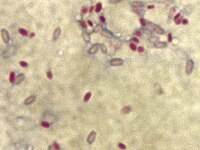Mycobacterium smegmatis
| Mycobacterium smegmatis | |
|---|---|
 |
|
| Scientific classification | |
| Kingdom: | Bacteria |
| Phylum: | Actinobacteria |
| Order: | Actinomycetales |
| Family: | Mycobacteriaceae |
| Genus: | Mycobacterium |
| Species: | M. smegmatis |
| Binomial name | |
|
Mycobacterium smegmatis (Trevisan 1889) Lehmann & Neumann 1899 |
|
Mycobacterium smegmatis is an acid-fast bacterial species in the phylum Actinobacteria and the genus Mycobacterium. It is 3.0 to 5.0 µm long with a bacillus shape and can be stained by Ziehl-Neelsen method and the auramine-rhodamine fluorescent method. It was first reported in November 1884 by Lustgarten, who found a bacillus with the staining appearance of tubercle bacilli in syphilitic chancres. Subsequent to this, Alvarez and Tavel found organisms similar to that described by Lustgarten also in normal genital secretions (smegma). This organism was later named M. smegmatis.
M. smegmatis is generally considered a non-pathogenic microorganism; however, in some very rare cases, it may cause disease.
M. smegmatis is useful for the research analysis of other Mycobacteria species in laboratory experiments. M. smegmatis is commonly used in work on the mycobacterium species due to its being a "fast grower" and non-pathogenic. M. smegmatis is a simple model that is easy to work with, i.e., with a fast doubling time and only requires a biosafety level 1 laboratory. The time and heavy infrastructure needed to work with pathogenic species prompted researchers to use M. smegmatis as a model for mycobacterial species. This species shares more than 2000 homologous genes with M. tuberculosis and shares the same peculiar cell wall structure of M. tuberculosis and other mycobacterial species. It is also capable of oxidizing carbon monoxide aerobically, as is M. tuberculosis.
The discovery of plasmids, phages, and mobile genetic elements has enabled the construction of dedicated gene-inactivation and gene reporter systems. The M. smegmatis mc2155 strain is hypertransformable, and is now the work-horse of mycobacterial genetics. Furthermore, it is readily cultivatable in most synthetic or complex laboratory media, where it can form visible colonies in 3–5 days. These properties make it a very attractive model organism for M. tuberculosis and other mycobacterial pathogens. M. smegmatis mc2155 is also used for the cultivation of mycobacteriophage. The complete genome of M. smegmatis has been sequenced by TIGR, and microarrays have been produced by PFGRC program (http://pfgrc.tigr.org/descriptionPages.shtml), adding further to its use as a model system to study mycobacteria.
...
Wikipedia
